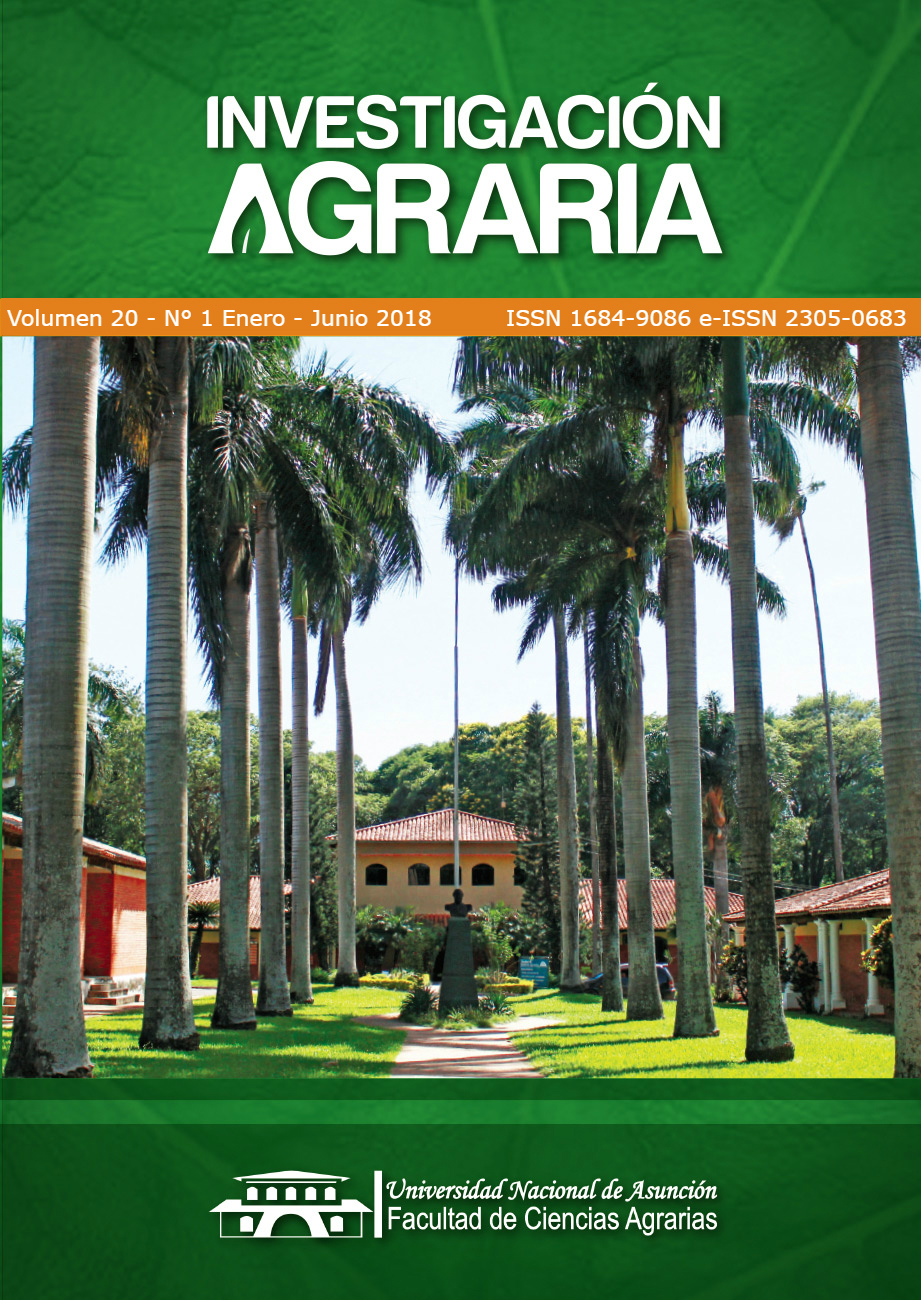Effects temperature on soybean and corn in Mato Grosso do Sul
DOI:
https://doi.org/10.18004/investig.agrar.2018.junio.30-37%20%20Keywords:
corn, soybean, temperatureAbstract
The influence of climate on agriculture has been constantly discussed in the academic setting. In this context, the results presented by the Intergovernmental Panel on Climate Change (IPCC) show that the sector most affected is agriculture. Brazil has an important role in this context, as a major world agricultural producer. The objective of this article is to verify the effects, without taking into account the production of the grains of each crop, but the minimum temperature on corn and soybean crops in the municipalities of Campo Grande, Chapadão do Sul, Dourados, Maracaju and São Gabriel do West in the state of Mato Grosso do Sul from 2008 to 2014, where the most recurrent probability of temperature is 5ºC to 14ºC. It was observed that there is great variability of temperature in Campo Grande of 14.70% for three frosts. Chapadão do Sul, the predominance is 17.25% of four frosts occur. In Dourados it can be verified that the predominance of two frosts is 27.07%. Maracaju can occur to the existence of eight frosts is 13.93%. And in São Gabriel do Oeste, it was found that there is a 13.81% probability of occurring up to eight frosts. The minimum air temperature is recorded under weather conditions while the minimum grass temperature is recorded near the surface of the ground. The Poisson distribution was used to measure if adverse temperature changes occurred between October and March, between 2008 and 2014, posing a risk to these crops.Downloads
Metrics
References
Agritempo (Sistema de Monitoreo Agrometeorológico, Brasil). 2015. Sistema de Monitoramento Agrometeorológico (em línea, sitioweb). Consultado el 05 de Fev 2015. Disponível em Disponível em http://www.agritempo.gov.br/agritempo/
Auffhammer, M; Hsiang, SM; Schlenker, W; Sobel, A. 2013. Using weather data and climate model output in economic analyses of climate change. NBER workingpapers. Cambridge, n. 19087. 32 p.
Assis, FN; Arruda, HV; Pereira, AR. Aplicações de estatística àclimatologia. 1996 Pelotas, Brasil, Universidade Federal de Pelotas, Editora Universitária.161 p.
Brunini, O; Camargo, MBP. 2000. Methodologies for assessing and quantify in gdrough tandfrostrisks in Brazil. Actas de la reunión de expertos de lãs associaciones regionales 3ra y 4ª sobre fenómenos agrometeorológicos adversos, 12-14 de julio de 1999, Caracas, Venezuela. Organización Meteorológica Mundial, Ginebra, Suiza. 31-43 p
Castro, NR. 2014. O impacto de variáveis climáticas sobre o valor da produção agrícola-análise para alguns estados brasileiros. Tese de Doutorado. Piracicaba, Brasil, Escola Superior de Agricultura “Luiz de Queiroz. 96p.
CEMTEC-MS (Centro de Monitoramento de Tempo, do Clima e dos Recursos Hídricos de Mato Grosso do Sul). 2015. CEMTEC-MS 6 anos de atividades no Estado (em línea, sitio web). Acesso em 25 Mar de 2015.Disponível em www.agraer.ms.gov.br
CONAB (Companhia Nacional De Abastecimento, Brasilia). 2014. Acompanhamento da safra brasileira de grãos. Brasilia, Brasil. CONAB. 1, n.1.
Da Silva, CA. 2011. Pensar, fazer ciência e desafios da pesquisa em climatologia geográfica no Centro-Oeste. Revista Mercator 9(1):39-51. [ Links ]
EMBRAPA CPAO (Embrapa Agropecuaria del Oeste, Brasilia). 2014. Embrapa (em línea, sitio web). Acesso em 06 dez. 2014. Disponible en: Disponible en: http://www.cpao.embrapa.br
FAO (Food And Agriculture Organization Of The United Nations). 2014. The statistic division - FAO stat (em línea, sitio web). Acesso em: 05 dez. 2014. Disponível em: Disponível em: http://faostat.fao.org/
LSPA (Levantamento Sistemático da Produção Agrícola, Rio de Janeiro). 2014. Pesquisa Mensal de Previsão e Acompanhamento das Safras Agrícolas no Ano Civil (em línea). Instituto Brasilero de Geografía e Estadísticas - IBGE 28(12) : 1-88. Disponível em: <ftp://ftp.ibge.gov.br/Producao_Agricola/Levantamento_Sistematico_da_Producao_Agricola_%5Bmensal%5D/Fasciculo/2014/lspa_201412.pdf>.
Oliveira, EF. 2003. Fatores que garantem o sucesso da safrinha de milho. Seminário Nacional de Milho Safrinha IAPAR (6º, 2003, Londrina, Brasil), IAPAR.
PBMC (Painel Brasileiro de Mudanças Climáticas, Brasil). 2013. Contribuição do Grupo de Trabalho 2 ao Primeiro Relatório de Avaliação Nacional do Painel Brasileiro de Mudanças Climáticas. Sumário Executivo do GT2. PBMC. Rio de Janeiro, Brasil, PBMC.
Sá Júnior, A. 2009. Aplicação da classificação de Köppen para o zoneamento climático do estado de Minas Gerais. Minas Gerais, Brasil, Universidade Federal de Lavras. 101 p.
Silva, JGDa; Sentelhas, PC. 2001. Diferença de temperatura mínima do ar mediano de abrigo e na relva e probabilidade de sua ocorrência em eventos de geada no Estado de Santa Catarina. Revista Brasileira de Agrometeorologia 9(1): 9-15.
Vianello, RL; Alves, ARA. 2000. Meteorologia Básica e Aplicações. Minas Gerais, Brasil, Viçosa-MG, UFV, 385 p.
Downloads
Published
How to Cite
Issue
Section
License
Copyright (c) 2018 Investigación Agraria

This work is licensed under a Creative Commons Attribution 4.0 International License.
All content in this journal is under Creative Commons Attribution License.









 All content in this journal is under
All content in this journal is under 